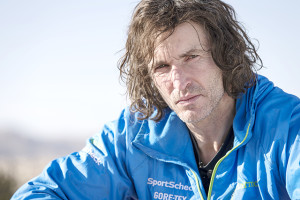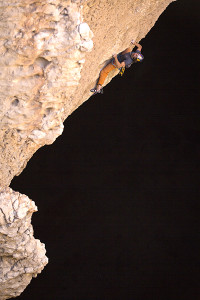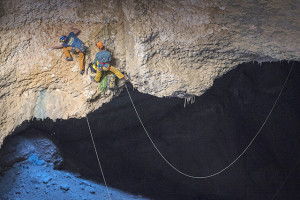Occupation: Climber and adventurer
Nationality: German
Age: 49
Climbing legends Stefan Glowacz and Chris Sharma descended to the bowels of the Majilis al Jinn (which means the “gathering place of the spirits”) in Oman to climb up the roof of the world’s second largest known cave chamber on a never attempted before route. The athletes negotiated 13 pitches with overhanging inclines, and even though Stefan suffered an injury, they grit their teeth and conquered it. Red Bull athlete Stefan talks more about their epic “Into the Light” project.
How did you get into climbing?
I got into climbing when I started walking. My parents loved the mountains and I grew up hiking in the Alps with them. I always climbed every rock along our way. As I grew older the rocks got bigger, the walls steeper. That’s how it all started.
Why choose to do the Majilis al Jinn cave?
When I saw the cave I knew I had to see if there were lines you could climb. I’ve climbed all kinds of walls. I’ve never climbed a cave. I found the idea fascinating to lower yourself into the dark bowels of the earth and then try to climb back up into the light. And the Majilis al Jinn cave is simply breathtaking. It’s one of the most awe-inspiring places I’ve been to. When the idea took form, I realised that the lines that seemed climbable were all very hard, long and steep. No one has tried to climb the cave. Exactly the kind of challenge I like!
How did you train and prepare for this climb?
Training is part of my life. I train several hours a day, every day. I get up early to get the most out of my day and combine endurance and strength training. I knew the Majilis al Jinn would require a good amount of prep training since the climb is hard and long. For endurance, I prefer to bike for several hours and combine that with climbing long, hard routes, preferably multi-pitches and compliment that with boulder training.
How did you manage the climb in two weeks?
We pulled hard, climbed all day. We didn’t take rest days and put all our energy into the route. Our strategy was to get the moves needed to climb down in our heads while we were setting up the route. We studied and memorised the rock. We tried as many sections as we could while setting. I think Chris and I were the perfect team for this kind of climb and this kind of tight schedule.
What were the most difficult and easiest parts of the routes?
This route is really strange. Every single pitch is super steep and overhanging but in the middle of the roof there is a traverse we managed to climb with our trekking boots. We called it the adventure hike. We could not figure out the dimensions from the ground. It was very hard to get any beta through the binoculars. Climbing this route was a bit like trial and error. And of course the tight schedule was one of the biggest difficulties.
Did you have any unfortunate moments during the climb?
When I was cleaning a pitch, both jumars unhinged and I fell. I grabbed the rope instinctively and severely burned both my hands. The second I grabbed that rope I thought, “You idiot!” When I felt the pain and saw my hands, I thought that was it. I didn’t want to put anybody down and Chris was totally motivating. I knew I wouldn’t be able to climb the hard pitches, but with Chris as partner it was clear it could be done. We had a doctor with us but with burns you need time. There was nothing we could do. So we had the choice to cancel the project or just do it. So I taped my hands and let Chris climb the tough pitches. It was a great team effort.
What was the most eye-opening experience from this trip?
To see Chris climbing. When I started climbing, I always had “older” role models. Now when you get older, I am more fascinated by the young generation. Most of all I am inspired by Chris because of his way of thinking about climbing and life.
What are your next projects?
In the summer I am going to Asia for climbing and at the beginning of 2015 I’m going back to Patagonia with Robert Jasper. With him I climbed “Gone With the Wind” on Cerro Murallon in Patagonia and “Take the Long Way Home” in Baffin Island.
What would you advise those who want to get into this sport
in the Middle East?
I wouldn’t recommend anybody who is an inexperienced climber to go climbing somewhere unexplored. If you want to experience climbing in the Middle East I suggest you begin with the main crags like Dibba or Hatta and go from there. Exploring new areas is always connected with getting permission to climb there. Get all the info you can before going!




